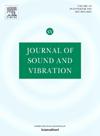Enhancing gearbox fault diagnosis under phase estimation errors: A dynamic time warping and blind deconvolution approach
IF 4.3
2区 工程技术
Q1 ACOUSTICS
引用次数: 0
Abstract
The blind deconvolution technique is widely used to extract subtle fault-related features from the noisy vibration signals of rotating machinery. However, utilizing conventional Minimum Entropy Deconvolution (MED) methods is challenging for analyzing gearboxes, where significant internal and external non-Gaussian disturbance signals are inherent. Although periodicity analysis with signal alignment can be employed to solve this challenge, most available methods require exact phase information for the signals; this must be measured by a specially installed encoder system. To address this issue, this paper introduces a novel method for the fault diagnosis of gearboxes that effectively addresses the significant challenge of extracting periodic fault characteristics from noisy vibration signals, particularly in scenarios characterized by significant phase estimation errors and without the need for an encoder system. By combining the strengths of blind deconvolution with Dynamic Time Warping (DTW)-based sequential signal alignment, our method facilitates the identification and alignment of samples with identical rotational phases. This approach enables the distinction between impulsive features caused by faults and those resulting from noise, thus overcoming the limitations of conventional techniques, which fail to extract periodic fault characteristics under phase estimation errors. The effectiveness of the proposed approach is verified through analytic simulation and experimental validation using data from 2-kW planetary gearbox testbeds at Seoul National University (SNU) and the Korea Research Institute of Standards and Science (KRISS). Results demonstrate the superiority of the proposed method for identifying fault conditions under significant phase estimation errors compared to conventional methods.
加强相位估计误差下的齿轮箱故障诊断:动态时间扭曲和盲解卷方法
盲解卷技术被广泛用于从旋转机械的噪声振动信号中提取与故障相关的微妙特征。然而,利用传统的最小熵解卷积 (MED) 方法分析齿轮箱具有挑战性,因为齿轮箱本身存在大量内部和外部非高斯干扰信号。虽然可以采用信号对齐的周期性分析来解决这一难题,但大多数现有方法都需要信号的精确相位信息;这必须通过专门安装的编码器系统来测量。为解决这一问题,本文介绍了一种用于齿轮箱故障诊断的新方法,它能有效解决从噪声振动信号中提取周期性故障特征这一重大挑战,尤其是在相位估计误差较大的情况下,而且无需编码器系统。我们的方法结合了盲解卷积和基于动态时间扭曲(DTW)的信号顺序对齐的优势,有助于识别和对齐具有相同旋转相位的样本。这种方法能够区分故障引起的脉冲特征和噪声引起的脉冲特征,从而克服了传统技术在相位估计错误的情况下无法提取周期性故障特征的局限性。通过使用首尔国立大学(SNU)和韩国标准与科学研究院(KRISS)的 2 千瓦行星齿轮箱试验台的数据进行分析模拟和实验验证,验证了所提方法的有效性。结果表明,在相位估计误差较大的情况下,与传统方法相比,拟议方法在识别故障条件方面更具优势。
本文章由计算机程序翻译,如有差异,请以英文原文为准。
求助全文
约1分钟内获得全文
求助全文
来源期刊

Journal of Sound and Vibration
工程技术-工程:机械
CiteScore
9.10
自引率
10.60%
发文量
551
审稿时长
69 days
期刊介绍:
The Journal of Sound and Vibration (JSV) is an independent journal devoted to the prompt publication of original papers, both theoretical and experimental, that provide new information on any aspect of sound or vibration. There is an emphasis on fundamental work that has potential for practical application.
JSV was founded and operates on the premise that the subject of sound and vibration requires a journal that publishes papers of a high technical standard across the various subdisciplines, thus facilitating awareness of techniques and discoveries in one area that may be applicable in others.
 求助内容:
求助内容: 应助结果提醒方式:
应助结果提醒方式:


